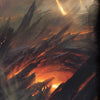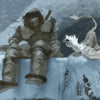Crafting with Monster Parts in D&D 5e

Written by Luke Hart
If you’re a dungeon master and you’ve never had a player try to harvest the internal organs of a basilisk, remove the scales and lungs from a dragon, or any number of equally wonderful, wholesome acts of desecration and defilement to the corpses of foes—well, you just haven’t been a dungeon master long enough. Because it will happen!
When it does, what are you going to do? The D&D core rules do not give us DMs any guidance on how to adjudicate this very common practice of ripping out pieces of monsters and then trying to turn them into useful, often magical, items.
However, do not fear. My team and I have created a lightweight ruleset—Reimagining the Bounty of the Land—that covers foraging and harvesting plants and monster parts and how to turn them into cool stuff the characters can use on their adventures.
Let’s walk through the three basic steps of how this rule system works—locating components, harvesting components, and crafting cool stuff—so if you want to use it in your games, you can. I’ll try to give enough information here so you don’t have to buy if you don’t want to, but doing so will save you some time and having to sort out granular details yourself.
Watch or listen to this article by clicking the video below.
1. Locating Components
Monsters
After the characters defeat an enemy, they may spend one hour (this hour requires active work and cannot coincide with a short rest) making an Intelligence (Arcana or Investigation) check to determine what might be useful, depending on whether they are searching for magical or mundane components from the creature. If the character already knows what they are looking for, they have advantage on the check but still need to roll to determine if they can find it undamaged. The difficulty of the check depends on the way they killed the creature:
- If the creature is unconscious, a DC 15 check is required to determine if there are useful components. Because it is not dead, the creature has a 50% chance of regaining consciousness and immediately attacking the nearest character. Unless the character has a passive Perception of 20 or higher, the character is surprised, and the creature has advantage on its first attack.
- If the creature was killed by elemental damage, a DC 20 check is required.
- If the creature was killed by bludgeoning, piercing, or slashing damage, the DC is 25.
- If the fatal blow dealt more than 50% of the creature’s maximum HP, the DC is 30 due to the intense, violent trauma causing extensive damage.
Succeeding on the check uncovers one useful component from the creature, per the creature type and its useful components chart. If the character specified a particular component they were searching for, they find it if it exists. Otherwise, select randomly from the list. Rangers examining their favored enemy may treat any roll of 9 or lower on this check as a 10.
Plants
When a character decides to forage for useful plants, they first need to determine if there is anything useful in the area. Depending on the character’s familiarity with the environment and what they wish to do, this can involve one or more rolls using various skills. Characters can accomplish this independently or working together.
Most characters will need to observe the area for signs or clues about what species of useful plants grow in the area, if any. Doing so requires one day of effort and can be accomplished in a few different ways:
- Intelligence (Nature) is helpful for recalling written or spoken information about useful plants in the area. Things like local superstitions or oral histories would likewise fall into this category.
- Intelligence (Investigation) is best for characters trying to discern what markings, growths, and other distinct features might mean for plants and their utility.
- Wisdom (Survival) may be appropriate when observing the area to see what plants are avoided, indicating they may be poisonous, or, perhaps, to see which plants attract wildlife, which may indicate they have beneficial properties.
- Wisdom (Medicine) can be used specifically for finding medicinal herbs, though its utility is limited when searching for magical or poisonous plants.
As with any situation, other skills may be applicable depending on what the characters are trying to find. Additionally, rangers in their favored terrain can treat any roll of 9 or lower on this check as a 10, as they have an unsurpassed knowledge of the area.
Then, you use the search chart to adjudicate the result of the check; basically, the higher the result, the better the chance of finding something useful.
Remember, all these charts and the detailed rules I’m going over are contained in the Reimagining the Bounty of the Land ruleset.
2. Harvesting Components
Monsters
Once the characters have determined what useful components they may be able to harvest from the felled creature, they may attempt to extract them. This is often a complicated process that requires at least an hour, though complicated corpses may even take a full day; even seemingly simple tasks such as collecting the goo of an ooze are complicated by the various sinews and skins that creatures have. When a character is prepared to begin harvesting a creature, they should select from the following skills:
- Dexterity (Sleight of Hand) to properly guide a tool through the harvesting process without damaging anything.
- Intelligence (Investigation) to determine how the object is attached to or interacting with the rest of the corpse.
- Intelligence (Nature) can be used to discern the optimal approach based on the character’s background knowledge.
- Wisdom (Survival) is a viable alternative to making a Dexterity (Sleight of Hand) check.
- Wisdom (Animal Handling) may also be used, particularly if the creature is a beast or beast-like.
The DC to successfully harvest a creature is equal to 10 + the creature’s CR, with a maximum of 30. If the character fails the check the first time, they may make a second check using a different skill option. If the character succeeds the second time, they harvest the target component, but they have disadvantage on all checks to use it, and it is worth half as much if sold.
Plants
Once the characters have located plants that may be useful, the next thing they will need to do is attempt to harvest them. Harvesting plants requires a full day’s work, accounting for traveling to the plants, preparing the relevant tools, and the act of harvesting. It also accounts for the time spent gathering the plants after the harvest is done and the time it takes to avoid making costly mistakes that damage the plants. The plant’s rarity determines the difficulty of harvesting it; the rarer it is, typically, the more fragile it is.
When preparing to harvest plants, characters should select one of the following options:
- Dexterity (Sleight of Hand) if they intend to use a knife to cut the plant carefully.
- Dexterity or Wisdom (Herbalism Kit) if they want to use the specialized tools in an herbalism kit to collect the harvest. The character can choose either ability score as long as they are proficient with the herbalism kit.
- Intelligence (Nature) if the character wants to use the technical information they have learned to attempt to harvest their finds.
- Wisdom (Survival) if the character wants to use their intrinsic knowledge of the flora to harvest it properly.
Then, use the plant rarity chart to determine the difficulty of harvesting the plants.
If the characters succeed, they harvest the number of plants they find. If the characters fail to harvest the plants they located, they may make a second attempt. The second attempt must use a different skill option from the list above. If the second attempt succeeds, the characters only harvest half the number of plants they find, rounded up.
3. Crafting Useful Stuff
Once characters have obtained a variety of crafting materials from the world, it is only natural that they will want to use them. Doing so is a heavily involved task requiring significant concentration, gold, and time. Even the simplest items can take a week to craft, though making several of them simultaneously is often possible.
Crafting items takes at least one workweek of dedicated effort and an amount of gold per week, as determined by the rarity of the target item per the Cost, Difficulty, and Time to Craft chart. Spending more gold, such as to get higher-quality supplies, will increase the chances of success. The increase in gold must be multiplied by the number of workweeks spent. Additionally, the character must have a relevant tool proficiency and a matching set of tools to craft the target item. Finally, the character must expend ingredients per the item’s recipe.
Each week that the character spends on crafting, they will make three skill checks, and the results of those checks determine if they advance in their efforts to craft the item. First they make a tool check, and then they make two additional skill checks based on any skill of the character’s choice. Of course, the game master should always ensure they are relevant to the item being crafted. How successful the character is in advancing the crafting process is determined by the number of successes and failures they have across all three checks.
0 Failures. The time spent crafting has been an unmitigated success. Progress accelerated beyond what was initially hoped for, doubling the typical progress toward completion. Additionally, if there is still time left in the creation process, the character has advantage on one future check of their choice to craft the same item.
1 Failure. The week mainly passed uneventfully. If this was the last week needed to create the item, the item is complete. Otherwise, progress advances by one week.
2 Failures. The week was almost unsalvageable. While the crafting itself wasn’t set back, the ingredients were destroyed and must be obtained again.
3 Failures. The attempt at crafting went terribly wrong. The ingredients were destroyed, and progress on the overall crafting was set back by 50%.
Crafting recipes
Naturally, your players will want to know what exactly they can craft with the plants and monster parts they are harvesting. The possibilities are endless and limited only by your imagination. I suggest creating a handful of different recipes you can use on the fly when it comes up, but you’ll probably also need to improvise at the table. You might also just ask your players what they think or require their characters to spend downtime researching crafting recipes. All of these are fair approaches, in my opinion.
In our Foraging, Hunting, and Crafting system, we compile some sample crafting recipes to help you out, but our lists are far from exhaustive.
4. Selling the Bounty
It’s possible that the characters will forgo using the plants or creatures they harvest themselves and sell them instead to an experienced craftsperson or trader for an adequate sum of gold. You can use the rules for selling magic items as downtime in Xanathar’s Guide when the characters attempt to do so. However, you can also use the plant and harvested creature value charts to guide you as well. They suggest base prices based on the rarity of the plant or the Challenge Rating of the creature killed.
Reimagining the Bounty of the Land
Our light-weight ruleset, Reimagining the Bounty of the Land, for the fifth edition of the world's most popular roleplaying game provides a mechanism to forage plants and harvest monsters for rare ingredients which can then be used to craft magical items, potions, and more.
It Features:
- Rules for foraging for and harvesting plants.
- Rules for hunting creatures and harvesting their organs and body parts.
- Rules for crafting creature parts and plants into magic items.
- Sample crafting tables.
- Rules for selling the bounty.
If you'd like to get this ruleset along with 9 other 5e rulesets and get special bundle pricing, check out our Big Ruleset Bundle!
-
Posted in
Game Master How-To Articles







